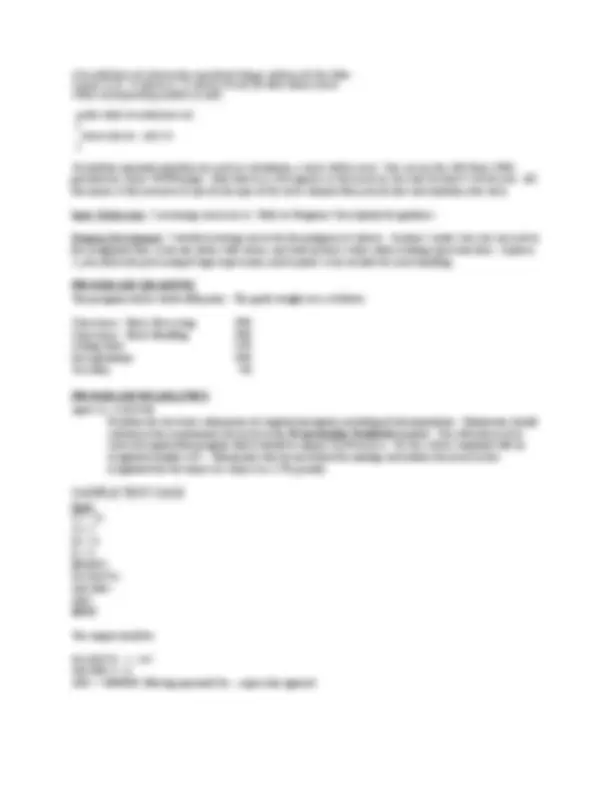



Study with the several resources on Docsity

Earn points by helping other students or get them with a premium plan


Prepare for your exams
Study with the several resources on Docsity

Earn points to download
Earn points by helping other students or get them with a premium plan
Community
Ask the community for help and clear up your study doubts
Discover the best universities in your country according to Docsity users
Free resources
Download our free guides on studying techniques, anxiety management strategies, and thesis advice from Docsity tutors
An assignment for a computer science 3310 course where students are required to write a program that evaluates postfix expressions. The input format, processing instructions, error handling, and output format. Students are expected to use a stack and an array to store operands and their corresponding values, and the program should be able to handle assignments, postfix expressions, and error checking.
Typology: Study notes
1 / 2

This page cannot be seen from the preview
Don't miss anything!


Your assignment is to write a program that evaluates postfix expressions. The form of a postfix expression and the algorithm for evaluating them are discussed in chapter 7 of your text on pages 349-351. In particular, the algorithm uses a stack for storing the operands until used in carrying out a calculation. For this program, the operands will be upper case letters and the operators will be from the set of characters {+,-,*,/}. The semantics for these operators conforms to their semantics in Java. Integer arithmetic will be used. In order to assign values to the upper case letters, the first portion of the input consists of assignments of integer values to letters. Any letter not assigned a value will have the default value of 0. The second portion of the input consists of postfix expressions to evaluate.
Input Format: The first portion of the input (one or more lines) consists of assignments of integer values to upper case letters. The letters are in no particular order, but no letter will be assigned two values. An example assignment line is
D = -
The integer values assigned to letters will be in the range of a 32 bit integer. The assignment lines always begin with the letter in column 1 of the input line. You may assume that there will be one or more spaces between each token (i.e. the
CBCAE-++-X-
Each of the input expressions will consist of only upper case letters and the four operators. The expression lines begin in column 1 and contain no embedded spaces. Any letter appearing in an expression but not assigned a value is assumed to have the default value of 0. You may also assume that the values of any calculations involved in evaluating an expression will all be in the range of a 32 bit integer.
The input is terminated by the sentinel line $END.
Input Processing:
Error Handling: The following error checking should be performed.
If any of these errors occur, a suitable error message should be printed, and the rest of the input expression ignored. You may use exception handling or traditional conditional logic for doing your error handling. Processing should resume with the next line. Error handling that causes termination of execution of the program will be severely penalized.
Output Format: See sample test case. The expression line should be echoed before the result is printed.
Data Structures: To keep up with the assigned values of the operands, use an array of 26 integers. A slight complication is that the array subscripts will run from 0 to 25, while the ASCII codes associated with the upper case letters range between 65 and 90. However, the following function will map an upper case letter into a number between 0 and 25 where 0 will correspond to ‘A’, and 25 correspond to ‘Z’.
// int addr(char ch) returns the equivalent integer address for the letter // given in ch, 'A' returns 0, 'Z' returns 25 and all other letters return // their corresponding position as well.
public static int addr(char ch) { return (int) ch - (int) 'A'; }
To hold the operands until they are used in calculations, a stack will be used. You can use the API Stack (URL provided on course WWW page). Note that it is a Java generic as discussed in class and Section 9.4 of the text. All this means is that you have to specify the type of the stack element when you declare and initialize your stack.
Input Redirection: I encourage you to use it. Refer to Program 2 description for guidance.
Program Development: I would encourage you to do this program in 3 phases. In phase 1 make sure you can read in the assignment lines, associate letters with values, and look up those values when reading expression lines. In phase 2, you add in the processing of legal expressions, and in phase 3 you include the error handling.
This program will be worth 150 points. The grade weights are as follows.
Correctness - Basic Processing 50% Correctness - Error Handling 20% Coding Style 15% Documentation 10% Test Plan 5%
April 14, 11:00 P.M. Deadline for electronic submission of completed program, including all documentation. Submission should conform to the requirements discussed in the Programming Standards handout. You will only need to send your application program which should be named PostEval.java. Use the submit command with an assignment number of 4. Submissions that do not follow the naming conventions discussed in this assignment for file names are subject to a 25% penalty.
Input: C = - X = 5 H = 25 D = 4 $PART DC+HX*C-- AH-DB+/ AH+- $END
The output would be
DC+HX*C-- = - AH-DB+/ = - AH+- = ERROR: Missing operands for -, expression ignored.